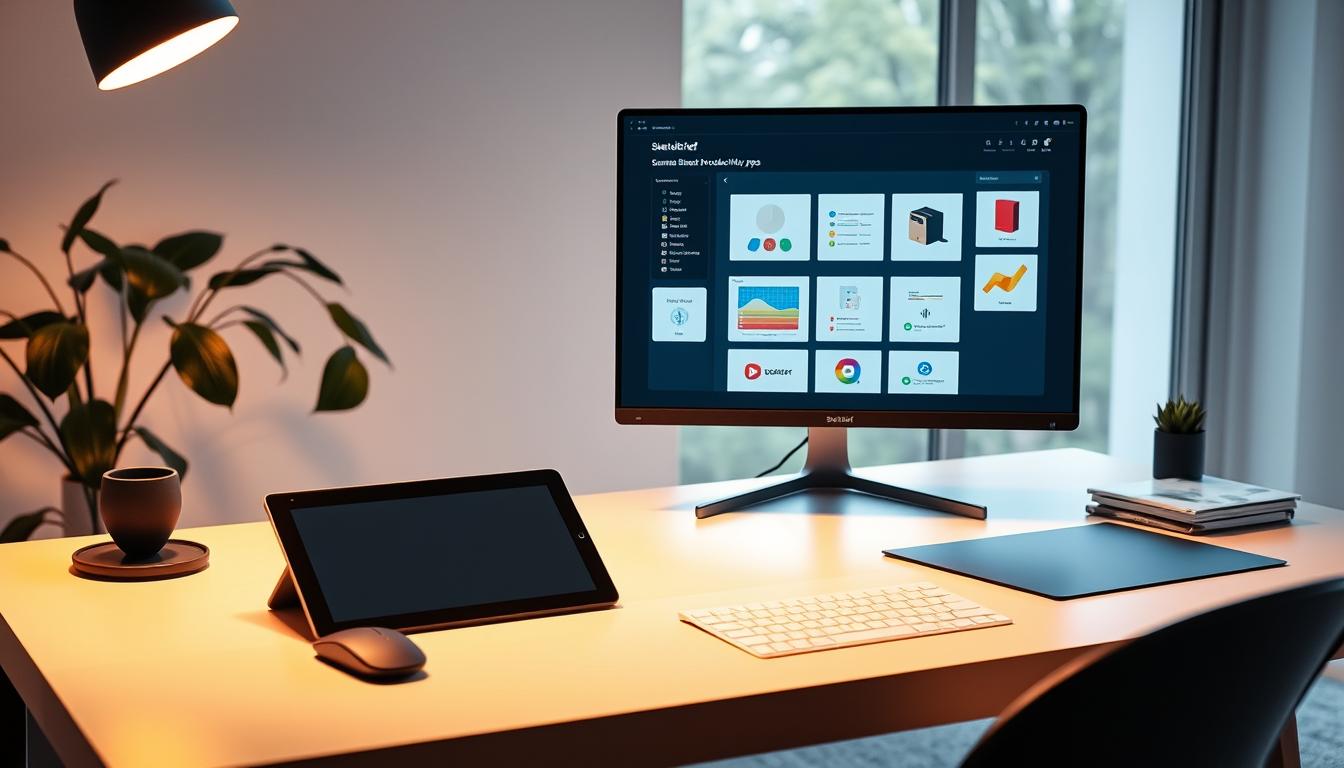Can one digital stack really cut days off your approval cycles and lock down sensitive data without slowing teams? We think so. In this intro we set expectations for a practical roundup that shows how a modern paperless office transforms processes for any business.
We explain how PDF editors like Adobe Acrobat DC and e-signature platforms such as DocuSign connect with Google Drive, Dropbox, and Salesforce to speed agreements. You’ll see collaboration software—Docs, Sheets, Trello, Asana—and client-facing systems like Clinked and Uniqode work together.
Our focus is outcomes: better document management, stronger security, measurable productivity gains, and saved time. We recommend the best paperless approaches for startups through enterprises and map a quick pilot plan you can run this quarter.
Key Takeaways
- We show category leaders for PDFs, e-signatures, cloud collaboration, and unified communications.
- Expect faster approvals, clearer audit trails, and fewer manual steps.
- Security matters: encryption, permissions, version history, and redaction.
- Choose solutions that integrate with your CRM and file storage to cut friction.
- Start small with pilots that deliver quick time and productivity wins.
- Recommendations fit hybrid teams and mobile-first workflows in 2025.
Why Going Paperless Now Boosts Productivity, Cuts Costs, and Secures Data
Moving key processes into searchable digital systems shortens approval cycles and lowers costs for your business. We see immediate gains in productivity and clearer controls when teams stop routing physical forms.
Present-day drivers: workflow efficiency, security, and reducing waste
Digitized documents are searchable, versioned, and take no floor space. That speeds audits and ends arguments over which file is final.
Security improves when sensitive data is redacted, shared via permissions, and logged instead of sitting in mailrooms. Duplex defaults and paperless statements help with reducing waste and your sustainability goals.
Commercial intent: how the right solutions replace paper and accelerate outcomes
From the CIO playbook: track pages printed per user, centralize printers, and nudge behavior to reduce paper without heavy change management.
- Faster cycles: fewer manual steps and better visibility across documents in flight.
- Lower costs: reduced print, postage, and storage spend plus reclaimed workspace.
- Better governance: timestamps, user actions, and retention policies that paper cannot match.
The bottom line: a deliberate shift to a paperless environment compounds productivity gains across teams and improves management visibility for leaders.
How to Choose Paperless Office Software for Your Business Needs
Start your vendor evaluation by mapping the specific document flows and risks that matter most to your teams. That clarity keeps the buying process practical and fast.
Security and compliance come first. Evaluate encryption at rest and in transit, redaction, access controls, and audit logs to protect documents end-to-end. Confirm ESIGN and UETA support for signatures and check data residency for regulated records.
Integrations and usability decide adoption. Prioritize solutions that link with your CRM, ECM, and identity provider so data moves without manual re-entry. DocuSign connects to Salesforce and Google Workspace. Adobe Acrobat DC links with Dropbox and OneDrive and supports redaction. Foxit offers PDF Editor, eSign, and an SDK for ECM integration.
- Test real users to avoid slow rollouts that cost time.
- Model total cost: licenses, setup, training, and admin.
- Check collaboration features—version history, permissions, commenting.
- Run a short pilot with clear metrics: turnaround, touches, and print counts.
| Criteria | What to Verify | Why it Matters |
|---|---|---|
| Security | Encryption, redaction, SOC 2, pen tests | Protects sensitive records and supports audits |
| Integrations | CRM, ECM, ID provider, APIs | Reduces manual steps and sync errors |
| Usability & Cost | User testing, total cost modeling | Ensures fast adoption and realistic ROI |
Top paperless office tools
Below are the apps and services we recommend to centralize documents, approvals, and client interactions.
Adobe Acrobat DC
Creates, edits, converts, and redacts PDFs while syncing with Dropbox and OneDrive. Teams get consistent files and fewer version conflicts.
Foxit PDF Editor + eSign
Foxit pairs a powerful PDF editor with eSign and a developer SDK. It supports interactive forms and ECM integration for tighter document management.
DocuSign
Legally valid e-signatures with templates, routing, automated reminders, and integrations with Salesforce and Google Workspace. It removes the printer from agreement workflows.
Google Drive
Drive anchors real-time collaboration in Docs, Sheets, and Slides. Strong search and shared drives keep files findable across teams.
Dropbox
Reliable cloud storage with version history, fast recovery, and two-factor authentication. Sharing and granular permissions reduce leakage risk.
OneNote and Evernote
Capture notes, photos, and web clippings. Tags, templates, and integrations make retrieval fast and organized for client work.
Trello and Asana
Trello uses boards and Butler automation for visible workflows. Asana adds timelines, workload, and reporting for complex project management.
Clinked
White-label client portals with bank-grade encryption so external stakeholders can exchange files and feedback securely.
RingCentral RingEX
Unifies meetings, messaging, internet fax, SMS, file sharing, and AI summaries—cutting app sprawl while keeping artifacts linked to conversations.
Uniqode
Replace paper business cards with digital business cards that share via QR/Wallet, track views and saves, and push contacts into your CRM.
“Pick the combo that maps to your workflows: PDF editing, signatures, cloud storage, and client portals.”
- Quick pick: Acrobat DC for PDFs, DocuSign for signatures, Drive or Dropbox for storage.
- Developer option: Foxit SDK to embed PDF features into your systems.
- Client-facing: Clinked and Uniqode make interaction and contact capture seamless.
Electronic Signatures for Contracts and Approvals
Electronic signing streamlines approvals and keeps contracts moving without printing. It speeds turnaround and creates clear audit trails for each executed agreement.
Legal validity under the ESIGN Act
The ESIGN Act of 2000 gives electronic signatures the same legal weight as wet signatures in the United States. That means you can execute binding contracts and retain admissible records without paper.
Best use cases and practical steps
We recommend standardizing templates—NDAs, MSAs, SOWs, and onboarding forms—to make every signing process fast and auditable.
- Operational wins: DocuSign provides routing, reminders, real-time status, and integrations with Salesforce and Google Workspace to cut follow-ups.
- Internal uses: policy acknowledgments, purchase approvals, HR forms.
- External uses: sales contracts, vendor agreements, renewals.
- Regulated workflows: capture identity checks, consent records, and tamper-evident certificates for audits.
- Governance: set retention schedules, access controls, and pair e-signatures with secure cloud storage and role-based permissions.
- Metrics: track cycle times and completion rates to quantify impact and find bottlenecks.
Train approvers on mobile signing so leaders can approve from anywhere and keep business moving.
PDF Editors, Forms, and OCR to Replace Paper Documents
Good PDF workflows cut friction across drafting, review, and long-term storage.
We recommend standardizing on Adobe Acrobat DC and Foxit PDF Editor to create, edit, convert, and redact files. Acrobat links with Dropbox and OneDrive for simple sync. Foxit pairs with Foxit eSign and ECM, and its Designer Assistant speeds interactive form setup.
Build interactive forms with required fields, validation, and conditional logic to capture accurate data the first time. Use templates and Foxit’s libraries to route forms and reduce manual handoffs.
- Apply ABBYY FineReader OCR to turn scans and photos into Word, Excel, and searchable PDFs so archives become digital files you can query.
- Embed annotations, comments, and stamps to centralize feedback and cut scattered email threads.
- Use the Foxit PDF SDK to add viewing, markup, and form submission into your own applications.
| Capability | Recommended Product | Benefit |
|---|---|---|
| Editing & Redaction | Adobe Acrobat DC | Consistent layout and secure redaction for sensitive document content |
| Interactive Forms | Foxit PDF Editor + Designer Assistant | Quick form templates, validation, and routing to signers |
| OCR & Conversion | ABBYY FineReader | Searchable, editable files from scans and photos |
“Standardize on PDFs, automate assembly, and integrate with ECM to keep finalized records governed.”
Cloud Storage and Document Management That Scale
When content lives in one managed place, your team spends less time searching and more time shipping. We recommend centralizing primary work in Google Drive or Dropbox so you can control sharing, recovery, and permissions across the business.

Google Drive and Dropbox: secure storage, sharing, and file recovery
Google Drive delivers real-time collaboration in Docs, Sheets, and Slides plus powerful search that surfaces documents and conversations. Dropbox adds robust version history, file recovery, and two-factor authentication to reduce accidental loss.
Both platforms integrate with common business apps and support secure links, granular permissions, and identity-provider single sign-on for streamlined access control.
Enterprise integrations and search to keep digital files easy to find
Define a folder taxonomy, metadata rules, and naming standards so teams locate files fast. Use version history and recovery to reverse mistakes and keep review cycles moving without rework.
- Centralize content to eliminate unmanaged local copies and simplify access control.
- Enable co-authoring and granular permissions to reduce duplicate files and off-platform attachments.
- Connect Drive or Dropbox to your identity provider and productivity suite for seamless workflows.
- Apply retention labels, sharing policies, and activity monitoring to protect sensitive documents and support audits.
| Need | Drive | Dropbox |
|---|---|---|
| Real-time collaboration | Docs/Sheets/Slides co-editing | Commenting and file requests |
| Recovery & Versioning | Version history, Drive trash | Version history, file recovery |
| Security & Access | Granular sharing, SSO, audit logs | 2FA, granular links, activity logs |
Collaboration, Communications, and Project Management Without Paper
A coordinated stack for messaging, task management, and client portals changes how employees share context and complete work.
Trello and Asana: streamline tasks, timelines, and reporting
Use Trello for lightweight boards, calendar views, Power-Ups, and Butler automation to keep handoffs visible and predictable.
When work grows complex, step up to Asana for custom fields, timelines, workload balancing, and robust reporting. These features help managers spot capacity issues and measure throughput.
Clinked client portals: branded, secure spaces for files and feedback
Clinked provides white-label client portals with bank-grade encryption so customers can upload files, review deliverables, and leave feedback without messy email threads.
RingCentral RingEX: meetings, messaging, and AI meeting notes
RingEX consolidates HD video, messaging, internet fax, SMS, file sharing, task management, and AI-generated notes and transcriptions to reduce context switching.
“Map cross-functional projects to portfolio views so leaders can spot risks, dependencies, and capacity constraints early.”
- Standardize intake with forms and templates to speed kickoffs and reduce ambiguity.
- Encourage asynchronous work with comments, @mentions, and clear task owners so employees work across time zones.
- Connect PM systems to storage and e-sign so completed tasks trigger file moves or approval requests automatically.
- Provide SLAs for reviews, train on filters and dashboards, and measure cycle time, throughput, and blocker frequency to remove friction.
A Practical Roadmap: How to Go Paperless in Five Steps
Start with a clear, phased plan that converts paper workflows into fast, auditable digital processes.
We recommend five focused steps from Foxit and CIO best practices. Each step removes friction and helps you replace paper with reliable digital alternatives.
Convert paper archives with high-performance scanning
Inventory records and prioritize by business value. Use high-performance scanners plus server software to batch, OCR, and route files to the right repositories.
Adopt e-signatures to replace physical signing and faxing
Roll out e-signature templates and role-based routing (Foxit PDF Editor + Foxit eSign) so approvals don’t wait for in-person signing or fax machines.
Digitize workflows with PDF SDKs and annotations
Embed PDF viewing and annotation via SDKs to keep reviews in context, reduce email threads, and speed the review process in your applications.
Replace paper forms with interactive PDFs
Use required fields, validation, and Designer Assistant to capture data and push it to systems of record automatically.
Standardize on a PDF editor and connect to ECM
Standardize on a single editor and integrate with ECM for classification, retention, and access controls enforced by design.
- Convert recurring reports directly to PDF so reviewers can comment and approve documents electronically.
- Decommission physical fax by switching to online fax services and capture inbound items into repositories.
- Pilot by department, measure cycle time and print reduction, then scale with clear guides and ownership.
| Step | Action | Outcome |
|---|---|---|
| 1 | Scan & OCR archives | Searchable, routed documents |
| 2 | Deploy e-sign templates | Faster approvals, audit trail |
| 3 | Embed SDK & annotations | Contextual reviews, fewer emails |
| 4 | Build interactive forms | Accurate data and automation |
| 5 | Standardize editor + ECM | Governance and retention |
“Pilot fast, measure time and print reduction, then expand with clear ownership for taxonomy and templates.”
Real-World Constraints and Smart Ways to Reduce Paper Usage
Aiming for zero paper is noble, but real-world needs call for pragmatic hybrid strategies. We accept that client rules, legal requirements, and some paper-friendly workflows will persist. Design a plan that limits paper without blocking critical business work.

Be realistic about requirements
Some clients and regulators still request signed or printed copies. Build exceptions into SOPs so teams know when a physical copy is needed and when documents can move electronically.
Behavioral nudges that lower consumption
Track pages per employee and consolidate printers to central zones. Default duplex printing and make single-sided prints slightly harder to request. These nudges cut paper usage fast.
Digital substitutes and process changes
Switch to online fax services and generate reports as PDFs for approvals. Use dual monitors or split-screen on a computer to review two digital files side-by-side.
Capture, OCR, and reduce recurring mail
Encourage mobile capture of receipts and business cards with apps like Scanner Pro and CamCard. Standardize OCR (ABBYY FineReader) so scanned content lands in cloud storage and is searchable.
Culture and measurement
Promote reuse and recycling, free up physical space, and publish quick SOPs for exceptions. Review print and scan metrics quarterly to tune defaults, training, and software investments.
“Design a hybrid approach that minimizes paper while keeping compliance and client trust intact.”
Conclusion
Small pilots bring fast wins. Start where approvals and intake forms slow you down. Focus on cloud storage, standardized PDFs, and e-signatures to cut paper and reclaim time.
We recommend Adobe Acrobat DC or Foxit for PDFs, DocuSign for legally valid signatures, and Drive or Dropbox for shared files. Add Trello or Asana for task flow and RingCentral RingEX to keep conversations and artifacts linked.
Keep people central: give clear templates, training, and rules so employees adopt the new way. Measure cycle time, reduced paper usage, and saved time to prove value quickly.
Choose a single pilot, set success metrics, and iterate. With a pragmatic roadmap and the right paperless office tools and software, you’ll lower costs, tighten security, and boost productivity across your business.

Leave a Reply